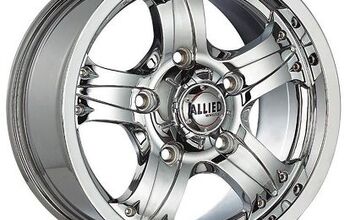Trade War Watch 16: Hot Wheels Just Got Hotter

It’s been some time since since we had a “ Trade War Watch” on mounting trade tensions in the auto industry, and thank goodness for that. In this economic climate of cuts, currency swings and bankruptcies, what we need are things which will make the situation worse, right? In May I reported about how the EU put a 20.6 percent tariff on aluminium wheels from China. The EU did this in response to complaints from domestic manufacturers. Naturally, this left a sour taste in China’s mouth. Well, over 5 months later, you’d think that the EU would have calmed down and this nasty business would be swept under the carpet, right? Erm, not quite….

More by Cammy Corrigan
Latest Car Reviews
Read moreLatest Product Reviews
Read moreRecent Comments
- Probert They already have hybrids, but these won't ever be them as they are built on the modular E-GMP skateboard.
- Justin You guys still looking for that sportbak? I just saw one on the Facebook marketplace in Arizona
- 28-Cars-Later I cannot remember what happens now, but there are whiteblocks in this period which develop a "tick" like sound which indicates they are toast (maybe head gasket?). Ten or so years ago I looked at an '03 or '04 S60 (I forget why) and I brought my Volvo indy along to tell me if it was worth my time - it ticked and that's when I learned this. This XC90 is probably worth about $300 as it sits, not kidding, and it will cost you conservatively $2500 for an engine swap (all the ones I see on car-part.com have north of 130K miles starting at $1,100 and that's not including freight to a shop, shop labor, other internals to do such as timing belt while engine out etc).
- 28-Cars-Later Ford reported it lost $132,000 for each of its 10,000 electric vehicles sold in the first quarter of 2024, according to CNN. The sales were down 20 percent from the first quarter of 2023 and would “drag down earnings for the company overall.”The losses include “hundreds of millions being spent on research and development of the next generation of EVs for Ford. Those investments are years away from paying off.” [if they ever are recouped] Ford is the only major carmaker breaking out EV numbers by themselves. But other marques likely suffer similar losses. https://www.zerohedge.com/political/fords-120000-loss-vehicle-shows-california-ev-goals-are-impossible Given these facts, how did Tesla ever produce anything in volume let alone profit?
- AZFelix Let's forego all of this dilly-dallying with autonomous cars and cut right to the chase and the only real solution.


































Comments
Join the conversation
Aluminium wheels are about 1 percent of the total cost of a car, therefore, the cost increase can’t be no more that 0.22 percent according to the EU. 1%? So on a $30,000 car you can buy four new wheels at the dealer for $300? Maybe they meant each wheel was 1%!
"The EU has 501,064,211 potential customers for Chinese products. China has 1,338,612,968."
Uh, that is not the only way to look at it nor is it the most relevant. The relevant number to look at the monetary balance of trade between the EU and China.
The most recent report I was able to find quickly dates to the first half of 2009. In that period the EU exported 37 Billion Euro worth of goods to China whilst importing 103 Billion Euro worth from China. Thus, China is fact has more to loose in a trade war with the EU than does the EU.
http://epp.eurostat.ec.europa.eu/cache/ITY_PUBLIC/6-27112009-AP/EN/6-27112009-AP-EN.PDF
The issue of comparative labor and environmental standards is likewise a very real one.